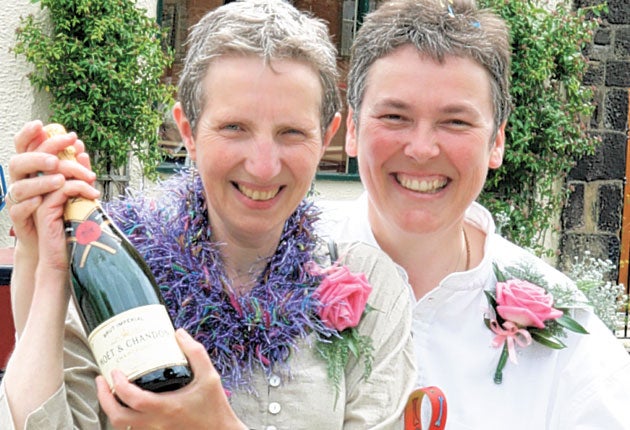Women lead men in same-sex unions – and in separations

The number of women entering into same-sex civil partnerships in the UK outstripped men last year for the first time since the legislation paving the way for such unions came into effect in 2005.
Figures published by the Office for National Statistics (ONS) reveal that the overall number of gay couples tying the knot appears to have stabilised, rising slightly from the 2009 figure to 6,385. The peak came in 2006 when 16,106 ceremonies were held.
But as the popularity of same-sex unions recovered, so the number of couples separating from each other rose by 44 per cent compared with the previous year. Women now account for nearly six out of 10 of all dissolutions and are twice as likely to separate than men, with 3.3 per cent of all female partnerships breaking up.
In 2010 the ratio of men to women in same-sex civil partnerships was 49:51. The change had already taken place in Scotland and Wales in 2007, followed by Northern Ireland in 2009, with England falling into line last year. In Scotland the total number of civil partnerships fell by 6.6 per cent to 465.
Meanwhile, the average age of men forming partnerships fell from 41.2 to 40.6. Women were also getting younger, with the average age falling from 38.9 in 2009 to 38.4 last year.
Gino Meriano, who runs the Gay Wedding Show, said the figures confirmed anecdotal evidence he had been observing in recent years. He said in the past year the value of the gay marriage market had increased from £44m to £51m.
"We have noticed a clear group of 30- to 38-year-old women coming into the show and the ratio of women for the past few years has increased," he said. "We are seeing around 75 per cent more women."
He said same-sex couples spent on average £8,000 to £10,000 on the ceremony and party to follow. Typically there were 40 to 60 guests – fewer than at a mixed-gender wedding. The top foreign honeymoon destination remains Canada, a pioneer in gay marriage rights, followed by Italy, Spain, Switzerland, the Czech Republic and Gran Canaria.
There are also more ways to celebrate, including the "two-aisle" arrangement which allows both fathers to escort their daughters down the aisle.
Under new reforms churches, synagogues and temples will be allowed to host civil ceremonies, although the Church of England still opposes allowing its premises to be used.
Case study: 'Our civil partnership gives us rights'
Evelyne Sansot and Sue Aldridge took the plunge in June 2006. "Before the change in the law you didn't have the same rights as other couples. If one of us had been in hospital – God forbid – you wouldn't necessarily have the rights to be with them or to be next of kin," Sue, 55, said.
"There are issues around inheritance and it is important to be recognised in society, and a civil partnership feels like a very political thing to show that it is all right to be gay and for gay people to have recognition of their union and their love."
The couple have since given up their jobs in academia and now specialise in photographing other civil partnerships with their company In The Pink.
"We are even happier now and our relationship gets stronger day by day," Sue said. Although they have no plans themselves, she believes more women are choosing to formalise their relationship because they want to have children.
Subscribe to Independent Premium to bookmark this article
Want to bookmark your favourite articles and stories to read or reference later? Start your Independent Premium subscription today.

Join our commenting forum
Join thought-provoking conversations, follow other Independent readers and see their replies